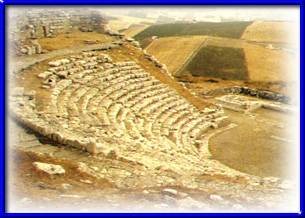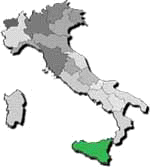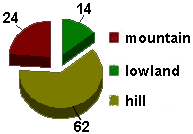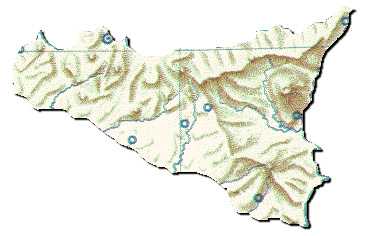Origin of the name:
The ancient inhabitants, the Sicanis, called
this Region Sicania. When it was colonized by Greek it was denominated
Trinachia, for the triangular form that it belonged. The name Sicily the taking
from the people of the Siculis.
| Reliefs - Passes - Coasts -
Islands: |
| The greatest part of the territory is
mountainous. In the northern zone it is placed Appennino Siculo, that is
divided in the three well separate zones: Peloritanis Mountains from which the
violent floods go down, Nebrodis Mountains (or Caronie) partly covered from a
miserable brushwood and with round tops and Madonies, where the tallest tops
are found: Pizzo Carbonara grazes the 2000 ms. The rest of the island doesn't
have other mountainous chains, but some single disconnected reliefs. In the
western zone Ghibellini Mountains are found. In the center-southern part
there are the highland Solfifero and Erei Mountains; in the zone oriental south
there are IbleiMountains where the volcano of Etna is found. Etna is still one
of the volcanos activate greater than the world. Its terminal cone reaches the
3269 ms. and it has covered big part of the year from the snows. Some level
zones are found in the proximities of Trapani, Marsala and Palermo, where
the fertile gold Basin rises.
|

Sees of historical center of Cefalù
|
To the feet of Etna is found Plain of Catania, which is
the vastest of the whole island.
The coasts are tall and jagged in the coastal tirrenico, they are low and in
some point swampy in the oriental part of the island, while in the southern
part it is sandy with dunes in some lines and swamps in others. Of Sicily makes
the archipelago of the Islands Eolie or Lipari it departs that is found to
north of the gulf of Milazzo. The islands that constitute the archipelago are:
Lipari, Salina, Panarea, Alicudi and Filicudi, Volcano and Stromboli. Last two
mention are still of the active volcanos. Instead the archipelago of Egadis is
found to the breadth of the western coast. The most important island is
Favignana. In Sea of Sicily Pantelleria and the Islands Pelagies are found with
Linosa and Lampedusa. In the waters of Tyrrhenian the island of Ustica rises.
Landscape:
Sicily proposes the most conflicting aspects of
all the Italian Regions. Expanses of fields of wheat and sterile hills, arid
zones and luxuriant gardens, the snows of the volcano and the torrid heat of
the coast can be found, big cities urban and depressing isolated countries. In
the zone delimited by Palermo, Messina and Syracuse the greatest part of the
population sicula it is thickened. This zone is very rich of vegetation; it
includes the tallest mountains and the longest rivers, but it is also the
rainiest zone. To south of this triangle, in the southern part of the island,
we find some very dry territories where the twenty African heats are
demolished.
Agriculture - Stock-farm -
Fishing:
Agriculture has developed especially in the
coastal lowlands. The principal products that are cultivate are: wheat, cereals
generally, citrus fruit, ulivo, fruit, vegetables. Very important is the
production of oil and wine; above all of the wines liquorosi as Marsala,
Moscato in Syracuse and Passito of Pantelleria. Cultivated intensely are the
almond tree, the core, the fig tree. The cotton is also cultivated. The
breeding in Sicily is not very developed: the pastorizia is more and more in
diminution and that of the cattle is scarce because of the lack of forage. The
production of good cheeses remains always tied up to the breeding. The fishing
is very flourishing, is that of the pescespada in Gulf in Messina, that that of
high ground with the blue fish, tuna, molluscs and shellfishes. The harbors
where the fishing is assembled more are those of Mazara of Vallo and Sciacca.
| Industry - Tourism: |

The doric Temple of Segesta
|
The industry of Sicilia is more than type
extractive, in how much there are a lot of mineral layers of a certain
importance. Notable is the production of salt, drawn from the mines of
salgemma and from the big salt pans. In the last years have been discovered
some oil layers that have determined the to build of refineries and other
industries to them connect. From to remember are the chemical establishments
and the alimentary industries. For many years the Gold Basin and Taormina have
been the tappes of the tourists of exception. From some time the tourism in
Sicily is revaluing the beauties that the Region possesses trying of to develop
the tourist economy. Tourist activity is becoming the principal source of
profit for Sicily, although is still distant from the realized possession all
its possibilities.
|
Position and Frontier:
Sicily has bathed to north from Tyrrhenian Sea,
to east from Ionian Sea and to South from Mediterranean Sea. Narrow of
Messina divides for alone 3 kms Sicily from the italian peninsula.
Rivers - Lakes:
The rivers of Sicily are to torrential character
and they have a brief course. If they had to compare, they would be
comparative, because very similar, with those of Calabria. The longest and more
capacious as course of water, is Simeto and Alcantara that flow in Ionian Sea.
In Tyrrhenian sea only Torto has a certain importance. In Mediterranean flow
Belice, Platani and Salso. The lakes of the Region are very small. In the
middle of the island there is Lake of Pergusa, that offers an unusual
phenomenon at times, that is that to let become waters all redheads because of
a natural trial of certain microorganisms that live inside.
Climate:
The climate is typically Mediterranean. When
steals the wind from Africa, says scirocco, the heat lifts the temperature
until to oppress. In the central part the climate is continental.
Population:
Sicily has always been one of the more populated
Italian regions and the demografic distribution has never been homogeneous.
Palermo and Catania are densely the more populated cities. In the inside of the
island we find some zones completely depopulate. The urban agglomerations are
differentiated for the type of economic activity that they develop. As in all
the southern regions we find in the countries the typical concentrations of
rural residences; the only zone where we find some isolated residences is in
her Plain one of Catania or in some points of the northern coast. In the last
years the move toward the cities has become intense because of the best
possibilities of job that the city can offer. The phenomenon of the emigration
toward the north or the foreign countries is always frequent. In the
proximities of Palermo, to Plain of Albanian, live a colony of Albanian that
has maintained their own customs in the customs , in the habits and in
the religion.
Communication:
The principal railway lines are Messina-Palermo
along the coastal tirrenico, Palermo-Catania-Syracuse along the ionic coast and
Palermo-Catania crossing the inside of the island. Modern motorway
constructions connect the varied cities. To Messina there is the port to which
do head the lines for Naples, Reggio Calabria, Villa St. Giovanni, while to
Palermo there are the lines for Cagliari, Naples, Tunisi and Ustica. The
airport fittings are found Point Raisi in the proximities of Palermo, to
Fontanarossa next to Catania and to Birgi, to few kilometers from Trapani.
Web Site designed by
MediaSoft - © Copyright 1998-1999 - All rights reserved






